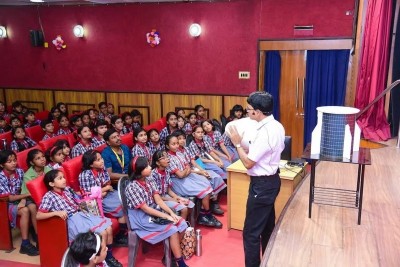December 05, 2025 09:50 am (IST)

New toolkit developed to help zoos create healthy home for chimps
Birmingham, May 11 (IBNS): University of Birmingham scientists have developed a new online toolkit that could help zookeepers in India to keep their great apes happy, healthy and behaving as they would in the wild.
Working with Twycross Zoo and the British and Irish Association of Zoos and Aquariums (BIAZA), the researchers have devised a new way to redesign chimp enclosures that will help preserve behavioural and physiological adaptations that make the species unique.
Their web-based Enclosure Design Tool is designed to keep the chimps physically and mentally active, as well as socially interactive, in a bid to ensure their behaviour in captivity emulates that of animals in the wild.
Experts aim to roll out the toolkit to cover all the great apes – bonobos, chimps, gorillas and orang-utans.
Chimps’ behaviour in captivity can be very different to the behaviour they exhibit in the wild where their environment can be unpredictable due to its complexity, for example, threat from predators or changing habitat due to forest growth and decay. In zoos, chimps can also be more sedentary and much like humans - prone to obesity and other illnesses.
The Birmingham-led team have created the enclosure design tool to give zoos easy access to research data on wild chimpanzees. They have also produced a web-based programme using this data to guide introduction of new features to chimp enclosures that emulate the forest canopy and the physical and cognitive challenges it poses to wild chimps.
For example, the team has introduced a network of interconnected straps and nets at Twycross Zoo, from top to bottom of the chimp enclosure. This contains the chimps’ bedding material and has foraging pockets containing their food.
The movement of the network of these supports changes depending on how many of the chimps are using them and what they are doing, making their habitat unpredictable and more challenging to move around. The chimps have to arm-hang from multiple flexible straps and duck, dive and bend in different ways, using movements which will build a more natural, wild-type musculo-skeletal system.
These enclosure changes are designed to mimic the wild environment encouraging the animals to behave like their wild counterparts in trees and move around using more natural behaviours.
Susannah Thorpe, from the University of Birmingham’s School of Biosciences, and lead investigator on the study, said: ”The chimps’ habitat in the wild is mechanically very challenging and different every day, so zoos need to be able to recreate a similar environment in captivity. But zoos rarely have ready access to research data on wild chimpanzee behaviour and the way they interact with their habitat. We have designed this tool to give zoos the ability to compare the behaviour of their animals to the latest research on wild chimps, and use that to create physically and cognitively stimulating enclosures that mimic, as closely as possible, the mechanics of forest habitats."
“Great apes are predicted to be extinct in the wild in around 20 years, so it is extremely important that we go beyond simply 'preserving' the animal for its genetic material to 'conserving the whole organism'- the behavioural traits and physical adaptations that are a vital part of what determines an animal's ability to survive in their natural environment. Our project is about ensuring that future generations of apes grow up in a complex and dynamic environment that is going to bring out these features to enhance their welfare, show the public how wild apes really behave and improve their chance of survival in the wild, should it ever be required.”
The researchers’ new enclosure design tool will be available through BIAZA and its CEO Kirsten Pullen said: “We encourage all our zoos to develop their welfare strategies to continuously promote the natural behaviours of the species in their care. This tool is a significant development in the range of techniques available to keep our zoos at the forefront of animal welfare.”
Jackie Chappell, from the University of Birmingham’s School of Biosciences, who led the project to develop the new tool, said: “The enclosure design tool is a web-based tool which provides all the information zoos need to collect and upload behavioural information on their animals. The tool then analyses this information automatically, providing bespoke, evidence-based advice about enclosure modification based on key differences between captive and wild behaviour.”
Charlotte Macdonald, Director of Life Sciences at Twycross Zoo said: “Twycross Zoo hosts a large number of research projects and facilitates scientific work with the aim to improve the welfare of the animals in our care. We are proud to be at the forefront of great ape conservation and this collaboration with the University of Birmingham provides an opportunity for making sure our enclosures enable our apes to behave as they would in the wild. Having implemented the recommendations based on this research into the enclosure design, we have already seen a positive change in our chimpanzees’ behaviour and locomotion to resemble wild chimps.”
Support Our Journalism
We cannot do without you.. your contribution supports unbiased journalism
IBNS is not driven by any ism- not wokeism, not racism, not skewed secularism, not hyper right-wing or left liberal ideals, nor by any hardline religious beliefs or hyper nationalism. We want to serve you good old objective news, as they are. We do not judge or preach. We let people decide for themselves. We only try to present factual and well-sourced news.
Support objective journalism for a small contribution.
Latest Headlines
Mother elephant rescues calf stuck on road, video melts internet
Thu, Oct 16 2025
Ranthambore scare: Tourists left stranded in tiger zone for 90 mins as guide flees safari
Sun, Aug 17 2025
Delhi: Royal Bengal Tiger Aditi gives birth to six cubs in zoo
Tue, Aug 05 2025
India's River Dolphin: Clear And Present Danger
Wed, May 28 2025
South Kashmir: The costs of coexisting with predatory wildlife
Mon, May 12 2025
Sariska Tiger Reserve: A maharani recognised
Fri, May 02 2025







